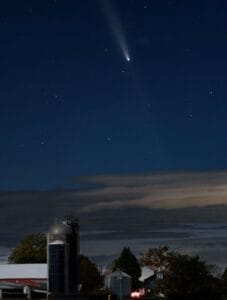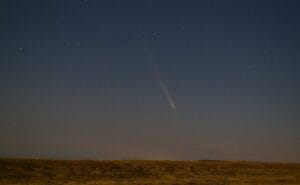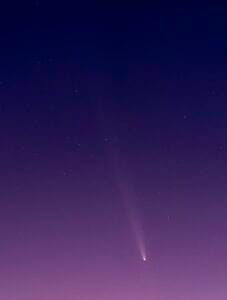Introduction to Comet C/2023A3 Tsuchinshan-ATLAS
Comet C/2023A3 Tsuchinshan-ATLAS has captured the imagination of skywatchers across the United States as it makes its remarkable journey through our solar system. Imagine witnessing a celestial phenomenon that only graces our skies once every 80,000 years! This comet, a once-in-a-lifetime opportunity for stargazers, is not just a dazzling display but a window into the mysteries of our universe.
What Makes This Comet Special?
This particular comet is remarkable for its rarity. Most comets come and go in a few years or decades, but C/2023A3 Tsuchinshan-ATLAS’s orbit means it won’t return for tens of thousands of years. It’s like catching a glimpse of a shooting star that has taken eons to reach our night sky!
Historical Context of Comet Sightings
Throughout history, comets have often been seen as omens or signs. From the Great Comet of 1811 to Halley’s Comet, each has left a mark on human culture and science. The excitement surrounding C/2023A3 continues this tradition, inviting a sense of wonder and curiosity among those who look up at the night sky.
The Journey of Comet C/2023A3
Discovery and Naming of the Comet
Discovered last year by astronomers at the Tsuchinshan Observatory in China, the comet was further studied by the ATLAS (Asteroid Terrestrial-impact Last Alert System) telescope in South Africa. This collaborative effort in astronomy is a great reminder of how global efforts lead to extraordinary discoveries.
Its Path Through the Solar System
C/2023A3 has traveled a complex trajectory, making its closest approach to the Sun in late September. This pass was a critical moment, heating the comet and causing it to shed gas and dust, forming its distinctive tail—a breathtaking sight for those fortunate enough to witness it.
Viewing the Comet
Optimal Viewing Times
The best time to view C/2023A3 has been during the weekends in early October. According to Shannon Schmoll, director of the Abrams Planetarium at Michigan State University, October 8 was a prime date for sighting as the comet began to emerge from the Sun’s glare.
Best Locations for Sightings
Reports of sightings have come in from various states, including California, Virginia, and New Hampshire. Ideally, you’d want to find a location away from city lights for the best view. Think about grabbing your friends and heading to a local park or observatory!
Equipment Needed for Observation
While the comet can be seen with the naked eye, binoculars will enhance the experience, allowing viewers to appreciate the comet’s detail as it moves higher in the night sky. So, whether you’re a casual observer or a serious astronomer, make sure to equip yourself properly!
Scientific Significance of Comet C/2023A3
What Scientists Hope to Learn
Astronomers are particularly excited about this comet because it offers a rare chance to study the building blocks of our solar system. The data collected could reveal insights about the early solar system, including the origins of water on Earth.
The Comet’s Composition and Origins
Scientists are keen to analyze the comet’s composition, which may include ice, dust, and organic compounds. Understanding what makes up C/2023A3 could help unlock the secrets of how comets contribute to planetary formation.
Stunning Visuals: Photos of the Comet
Notable Photography from Across the US
As the comet graces our skies, photographers have been capturing stunning images. These photographs not only document the event but also inspire awe. From breathtaking long-exposure shots to casual snapshots, the comet has sparked creativity among amateurs and professionals alike.
Techniques for Capturing Comet Photos
For those interested in astrophotography, patience and practice are key. Using a sturdy tripod, wide-angle lens, and a good camera can result in spectacular captures. Remember, the best shots often come after experimenting with various settings!
Public Engagement and Interest
Social Media Buzz Around the Comet
The comet has become a hot topic on social media, with users sharing their sightings and photos. Platforms like Instagram and Twitter have created a buzz, connecting enthusiasts and encouraging discussions around astronomy.
Community Events and Stargazing Gatherings
Many communities have organized stargazing events, allowing locals to come together to observe the comet. These gatherings provide a great opportunity to learn from experienced astronomers and share the wonder of the night sky.
The Future of Comet Observation
Upcoming Celestial Events
While C/2023A3 is a highlight, it’s just one of many celestial events to look forward to. Mark your calendars for meteor showers and other comets expected in the coming years—there’s always something exciting happening in the cosmos!
Other Comets to Watch
Keep an eye out for future comets making their way into our solar system. Each brings its own story and science, inviting us to explore and appreciate the universe’s grandeur.
Also read: The Penguin | The Penguin Episode 4 Review
Conclusion
As we bask in the glow of Comet C/2023A3 Tsuchinshan-ATLAS, it’s clear that this celestial event is not just a spectacle but a reminder of our place in the universe. With each sighting, we connect with the stars above, fostering a sense of curiosity and community. So, whether you’ve seen it yourself or missed the chance, the legacy of this comet will linger, igniting imaginations for generations to come.
FAQs
How often do comets like C/2023A3 appear?
Comets like C/2023A3 are extremely rare, typically appearing once every 80,000 years. However, there are many comets with shorter orbits that can be seen more frequently.
Can I see the comet without binoculars?
Yes, the comet can be seen with the naked eye, especially during its peak visibility. However, binoculars will provide a clearer and more detailed view.
What should I do if I miss the comet?
Don’t worry! There are always more celestial events on the horizon. Keep an eye on astronomy calendars for upcoming comets and meteor showers.
Are there any risks associated with comet sightings?
Generally, observing comets is safe. Just ensure you’re in a safe location and avoid looking directly at the sun during the day.
Where can I find more information about upcoming celestial events?
Websites like NASA, local astronomy clubs, and planetariums are excellent resources for information on upcoming celestial events and how to view them.




